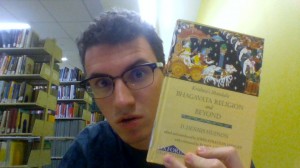Hudson, Dennis D. Krishna’s Mandala: Bhagavata Religion and Beyond. New Dehli: Oxford University Press, 2010

My started with a visit to the library’s catalog. From there I used a keyword search for “Vaishnavism,” because I feel like the different sects of the religions we have learned about, Hinduism in particular, could provide for fascinating research. Studying Vaishnavism could also further uncover the monotheistic aspects of Hinduism we mentioned in class. Krishna’s Mandala was the first return I got and upon further investigation, I saw the book had a whole chapter devoted to Vaishnavism. After seeing that the other chapters put an emphasis on scriptures in the scriptures of Hinduism, I realized this was the book for me and after a quick through the stacks, I had found what I was looking for.
Upon seeing the book, the cover immediately captivated me because of the interesting painting adorning the top of it. It appears to depict Krishna and another deity riding on a chariot pulled by many horses towards an army of elephants, which is wild. Looking into the table of contents, I came to discover the book is divided into three sections, each with their own chapters. The first section “Tales of Two Cities,” was split into four chapters, each of which describing the mythology behind the city of Madurai, a city in South India populated by the Tamils. The first chapter “Madurai: The City as Goddess” was of particular interest because it showed the connection between society and Hinduism. The city, along with other cities, was thought to symbolize a deity. The second section, “Reading Bhagavata Texts – Temples and Tomes,” seemed to highlight the history of the Bhagavad Gita and the role it played in society, specifically in the “The Initiation of the Emperor” chapter which appears to like the text to the monarchy. The third section titled “Antal and the Sri Vaishnava World,” was of particular interest to me because it finally addressed the sect of Vaishnavism, namely its founding and theology. Antal, a female goddess from the Bhagavad Gita, “expounds” Vaishnava traditions and is revered by the sect. This section especially helps when trying to relate Vaishnavism to the scriptures and its interpretation of them.
Near Krishna’s Mandala is saw many writings about the tantras and different sects of Hinduism as well as the tales of different religious figures. The various books on the tantras represents their importance in Hinduism, an importance that would be intriguing to investigate. The book titled Vaisnavism looked interesting and would be very helpful if I further research Hindu sects. Another book, Reconstructing Tradition, also seems like it would provide for an fascinating read as the ambiguity of the title leaves the door open to so many possibilities.